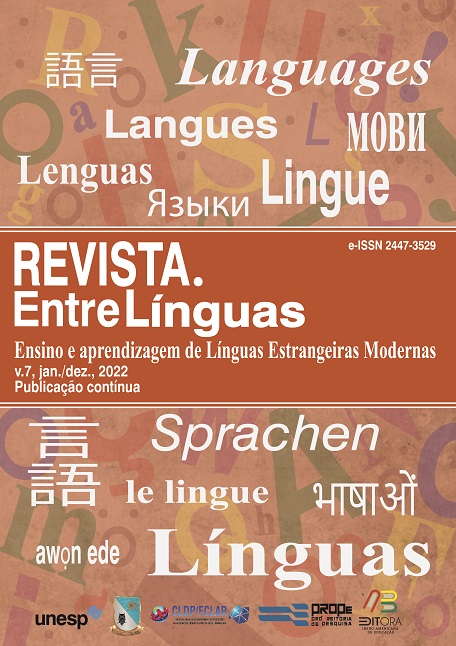Reproducción de la modalidad intersemiótica en la adaptación cinematográfica de la novela "Harry Potter y la Piedra Filosofal"
DOI:
https://doi.org/10.29051/el.v8i00.17592Palabras clave:
Traducción, Traducción intersemiótica, Modalidade, Adaptación cinematográfica, Harry PotterResumen
El artículo se centra en la cuestión de la formulación de la estrategia de reproducción de palabras modales en la traducción intersemiótica sobre el ejemplo de la adaptación cinematográfica de la novela "Harry Potter y la piedra filosofal" de J. K. Rowling. Este artículo tiene como objetivo describir las estrategias de adaptación de la reproducción de palabras modales en la traducción intersemiótica llevada a cabo durante la adaptación cinematográfica de una obra literaria, que pueden expresarse en la actuación, los gestos y los movimientos, así como en los respectivos planos. Este enfoque permite reflejar elementos como los fenómenos naturales, los edificios y los objetos móviles e inmóviles. Se exploró el uso de estrategias de adaptación tanto en la novela como en la adaptación cinematográfica, así como la modalidad del autor, y se presentó la comparación de los diálogos del libro y de la adaptación cinematográfica que contienen la modalidad. Se estableció que en las obras literarias, las palabras modales se encuentran con mayor frecuencia en las palabras del autor y en las reflexiones de los personajes, es decir, en los segmentos más susceptibles de corrosión durante la traducción intersemiótica. Por ello, para mantener la intención del autor, los traductores recurren a ciertas estrategias de adaptación. Por lo tanto, en este artículo se han identificado las principales estrategias de reproducción de palabras modales en la traducción intersemiótica a partir del ejemplo de la novela "Harry Potter y la piedra filosofal".
Descargas
Citas
ALGEO, J. A Comprehensive Grammar of the English Language. By Randolph Quirk, Sidney Greenbaum, Geoffrey Leech, and Jan Svartvik. London: Longman. 1985. x + 1779. Journal of English Linguistics, v. 20, n. 1, p. 122-136, Apr. 1987. DOI: 10.1177/007542428702000108. Available: https://journals.sagepub.com/doi/10.1177/007542428702000108. Access: 2 Apr. 2022.
ANDERSON, S. R. Linguistic expression and its relation to modality. In: ANDERSON, S. R. Current Issues in ASL Phonology. Elsevier, 1993. p. 273-290. ISBN 9780121932701. DOI: 10.1016/B978-0-12-193270-1.50018-2. Available: https://www.sciencedirect.com/science/article/pii/B9780121932701500182?via%3Dihub. Access: 2 Apr. 2022.
BRANCO, S. O.; SANTOS, L. S. O uso de atividades de tradução intersemiótica e interlingual em uma sala de aula de língua inglesa como le. Revista EntreLinguas, Araraquara, v. 3, n. 2, p. 203-226, Dec. 2017. DOI: 10.29051/rel.v3.n2.2017.9229. Available: https://periodicos.fclar.unesp.br/entrelinguas/article/view/9229/6966. Access: 2 Apr. 2022.
CAMERON, D. Language, Gender, and Sexuality: Current Issues and New Directions. Applied Linguistics, v. 26, n. 4, p. 482-502, Dec. 2005. DOI: 10.1093/applin/ami027. Available: https://academic.oup.com/applij/article-abstract/26/4/482/145308?redirectedFrom=fulltext. Access: 2 Apr. 2022 .
HERRING, S.; JOHNSON, D.; DIBENEDETTO, T. Participation in electronic discourse in a “feminist” field. In: COATES, Jennifer; PICHLER, Pia. Language and gender: A reader. 2. ed. Wiley-Blackwell, 2011. p. 171-182 .
HOLUBENKO, N.; DEMETSKAYA, V. Category of Modality Through the Prism of Multipole Approaches in the Modern Translation Theory. Journal of History Culture and Art Research, v. 9, n. 2, p. 303, June 2020. DOI: 10.7596/taksad.v9i2.2500. Available: http://kutaksam.karabuk.edu.tr/index.php/ilk/article/view/2500. Access: 2 Apr. 2022.
JAKOBSON, R. On linguistic aspects of translation. In: On translation. Harvard University Press, 1959. p. 232-239.
KAŹMIERCZAK, M. From Intersemiotic Translation to Intersemiotic Aspects of Translation. Przekładaniec, v. 34-35, p. 7-35, 2018. DOI: 10.4467/16891864epc.18.009.9831. Available: https://www.ejournals.eu/Przekladaniec/English-issues/Special-Issue-Word-and-Image-in-Translation/art/13048/. Access: 2 Apr. 2022.
KEANE, C. How to write a selling screenplay: A step-by-step approach to developing your story and writing your screenplay by one of today's most successful screenwriters and teachers. New York: Broadway Books, 1998. 308 p. ISBN 0767900715.
LIKHODKINA, I. A. (Reflection of literary images in cinema or features of intersemiotic translation. Philological sciences. Questions of theory and practice, v. 3-3, n. 69, p. 128-130, 2017. Available: https://elibrary.ru/item.asp?id=28831784. Access: 2 Apr. 2022.
MONEY, J. Hermaphroditism, gender and precocity in hyperadrenocorticism: Psychologic findings. Bulletin of the Johns Hopkins Hospital, v. 96, n. 6, p. 253-264, 1955 .
NIKONOVA, V.; BOYKO, Y. Gender-specific emotivity of Victorian female prose from a multidimensional perspective. Lege artis. Language yesterday, today, tomorrow, v. 4, n. 1, p. 47-82, 2019 .
NUYTS, Jan. Epistemic modality, language, and conceptualization: A cognitive-pragmatic perspective. John Benjamins Publishing, 2001.
O'BARR, W. M. Linguistic evidence: Language, power, and strategy in the courtroom. Elsevier, 2014 .
ROWLING, J.; KAY, J. Harry Potter and the philosopher's stone. Bloomsbury, 2017.
VOLD, E. T. Epistemic modality markers in research articles: a cross-linguistic and cross-disciplinary study. International Journal of Applied Linguistics, v. 16, n. 1, p. 61-87, Mar. 2006. DOI: 10.1111/j.1473-4192.2006.00106.x. Available: https://onlinelibrary.wiley.com/doi/10.1111/j.1473-4192.2006.00106.x. Access: 2 Apr. 2022.
Publicado
Cómo citar
Número
Sección
Licencia

Esta obra está bajo una licencia internacional Creative Commons Atribución-NoComercial-CompartirIgual 4.0.
Os manuscritos aceitos e publicados são de propriedade da Revista EntreLínguas. Os artigos publicados e as referências citadas na Revista EntreLínguas são de inteira responsabilidade de seus autores.
Transferência de direitos autorais – autorização para publicação
Caso o artigo submetido seja aprovado para publicação, já fica acordado que o(s) autor(es) autoriza(m) a UNESP a reproduzi-lo e publicá-lo na EntreLínguas, entendendo-se os termos “reprodução” e “publicação” conforme definição respectivamente dos incisos VI e I do artigo 5° da Lei 9610/98. O artigo poderá ser acessado pela rede mundial de computadores (Internet), sendo permitidas, a título gratuito, a consulta e a reprodução de exemplar do artigo para uso próprio de quem a consulta, desde que haja a citação ao texto consultado. Essa autorização de publicação 328 EntreLínguas, Araraquara, v. 1, n .2, p. 323-328, jul./dez. 2015 não tem limitação de tempo, ficando a UNESP responsável pela manutenção da identificação do(s) autor(es) do artigo. Os artigos publicados e as referências citadas na Revista EntreLínguas são de inteira responsabilidade de seus autores.











